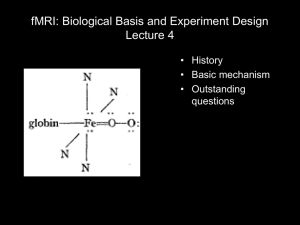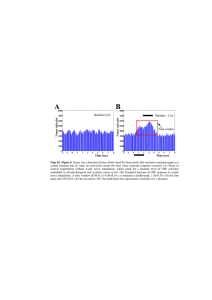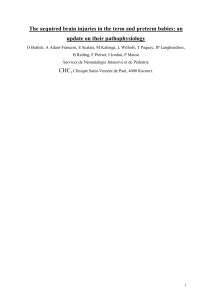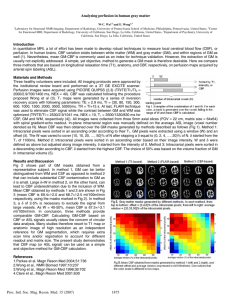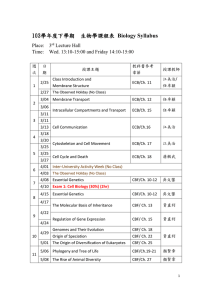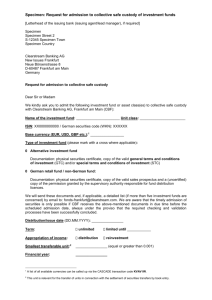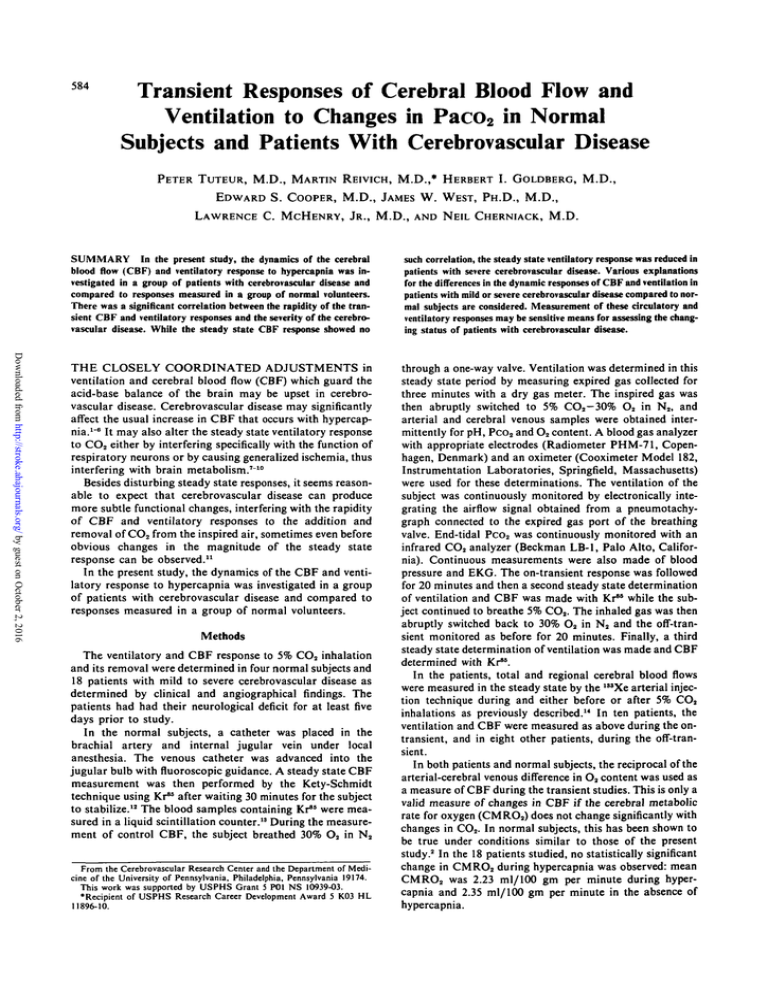
584
Transient Responses of Cerebral Blood Flow and
Ventilation to Changes in Paco 2 in Normal
Subjects and Patients With Cerebrovascular Disease
PETER TUTEUR,
M.D., MARTIN
REIVICH,
EDWARD S. COOPER, M.D.,
M.D.,*
HERBERT
I.
GOLDBERG,
JAMES W. WEST, PH.D.,
LAWRENCE C. MCHENRY, JR., M.D.,
M.D.,
M.D.,
AND NEIL CHERNIACK,
M.D.
Downloaded from http://stroke.ahajournals.org/ by guest on October 2, 2016
SUMMARY In the present study, the dynamics of the cerebral
blood flow (CBF) and ventilatory response to hypercapnia was investigated in a group of patients with cerebrovascular disease and
compared to responses measured in a group of normal volunteers.
There was a significant correlation between the rapidity of the transient CBF and ventilatory responses and the severity of the cerebrovascular disease. While the steady state CBF response showed no
such correlation, the steady state ventilatory response was reduced in
patients with severe cerebrovascular disease. Various explanations
for the differences in the dynamic responses of CBF and ventilation in
patients with mild or severe cerebrovascular disease compared to normal subjects are considered. Measurement of these circulatory and
ventilatory responses may be sensitive means for assessing the changing status of patients with cerebrovascular disease.
THE CLOSELY COORDINATED ADJUSTMENTS in
ventilation and cerebral blood flow (CBF) which guard the
acid-base balance of the brain may be upset in cerebrovascular disease. Cerebrovascular disease may significantly
affect the usual increase in CBF that occurs with hypercapnia.1'6 It may also alter the steady state ventilatory response
to CO2 either by interfering specifically with the function of
respiratory neurons or by causing generalized ischemia, thus
interfering with brain metabolism.7"10
Besides disturbing steady state responses, it seems reasonable to expect that cerebrovascular disease can produce
more subtle functional changes, interfering with the rapidity
of CBF and ventilatory responses to the addition and
removal of CO2 from the inspired air, sometimes even before
obvious changes in the magnitude of the steady state
response can be observed.11
In the present study, the dynamics of the CBF and ventilatory response to hypercapnia was investigated in a group
of patients with cerebrovascular disease and compared to
responses measured in a group of normal volunteers.
through a one-way valve. Ventilation was determined in this
steady state period by measuring expired gas collected for
three minutes with a dry gas meter. The inspired gas was
then abruptly switched to 5% CO2-30% O2 in N2, and
arterial and cerebral venous samples were obtained intermittently for pH, Pco2 and O2 content. A blood gas analyzer
with appropriate electrodes (Radiometer PHM-71, Copenhagen, Denmark) and an oximeter (Cooximeter Model 182,
Instrumentation Laboratories, Springfield, Massachusetts)
were used for these determinations. The ventilation of the
subject was continuously monitored by electronically integrating the airflow signal obtained from a pneumotachygraph connected to the expired gas port of the breathing
valve. End-tidal Pco2 was continuously monitored with an
infrared CO2 analyzer (Beckman LB-1, Palo Alto, California). Continuous measurements were also made of blood
pressure and EKG. The on-transient response was followed
for 20 minutes and then a second steady state determination
of ventilation and CBF was made with Kr86 while the subject continued to breathe 5% CO2. The inhaled gas was then
abruptly switched back to 30% O2 in N2 and the off-transient monitored as before for 20 minutes. Finally, a third
steady state determination of ventilation was made and CBF
determined with Kr85.
In the patients, total and regional cerebral blood flows
were measured in the steady state by the 1S3Xe arterial injection technique during and either before or after 5% CO2
inhalations as previously described." In ten patients, the
ventilation and CBF were measured as above during the ontransient, and in eight other patients, during the off-transient.
In both patients and normal subjects, the reciprocal of the
arterial-cerebral venous difference in O2 content was used as
a measure of CBF during the transient studies. This is only a
valid measure of changes in CBF if the cerebral metabolic
rate for oxygen (CMROj) does not change significantly with
changes in CO2. In normal subjects, this has been shown to
be true under conditions similar to those of the present
study.2 In the 18 patients studied, no statistically significant
change in CMRO2 during hypercapnia was observed: mean
CMRO2 was 2.23 ml/100 gm per minute during hypercapnia and 2.35 ml/100 gm per minute in the absence of
hypercapnia.
Methods
The ventilatory and CBF response to 5% CO2 inhalation
and its removal were determined in four normal subjects and
18 patients with mild to severe cerebrovascular disease as
determined by clinical and angiographical findings. The
patients had had their neurological deficit for at least five
days prior to study.
In the normal subjects, a catheter was placed in the
brachial artery and internal jugular vein under local
anesthesia. The venous catheter was advanced into the
jugular bulb withfluoroscopicguidance. A steady state CBF
measurement was then performed by the Kety-Schmidt
technique using Kr85 after waiting 30 minutes for the subject
to stabilize.12 The blood samples containing Kr85 were measured in a liquid scintillation counter.19 During the measurement of control CBF, the subject breathed 30% O2 in N2
From the Cerebrovascular Research Center and the Department of Medicine of the University of Pennsylvania, Philadelphia, Pennsylvania 19174.
This work was supported by USPHS Grant 5 PO1 NS 10939-03.
•Recipient of USPHS Research Career Development Award 5 K03 HL
11896-10.
RESPONSES OF CBF AND VENTILATION TO Paco2 CHANGES/r«/eur et al.
Results
Downloaded from http://stroke.ahajournals.org/ by guest on October 2, 2016
Table 1 lists the clinical and angiographical data in the 18
patients studied. On the basis of this information, the
patients were divided into two groups: Group 1, patients
with mild disease, and Group 2, patients with severe disease.
The age range of the patients in these two groups was
similar. Patients with mild disease were 37 to 61 years old,
while those with severe disease were 29 to 76 years of age.
Average steady state data for cerebral oxygen consumption
and cerebral blood flow and ventilatory response to CO2 are
shown in table 2. Results in the four normal individuals (age
range 20 to 25) were within the limits reported by other investigators for similar subjects.15"19
Table 2 shows that the CMRO2 is significantly reduced in
the patients with severe disease (p < 0.001) compared to
either the patients with mild disease or the normal subjects.
The ventilatory response to CO2 was significantly less in the
patients with more severe clinical cerebrovascular disease
than it was in either the patients with milder illness or the
control subjects. Also, the steady state CBF response was
nearly identical in the two patient groups. Correlation
between CMRO2 and the steady state CBF or ventilatory
response to CO2 was likewise poor (r = 0.32 and 0.25
respectively).
Examples of the time course of the increases in arterial
and cerebral venous Pco2, CBF and ventilation with 5% CO2
inhalation are illustrated in figure 1 in patients from the two
clinical groups and in normal subjects.
In the normal subjects the time course of the increase in
CBF was similar to that of arterial Pco2, but an overshoot
occurred in the CBF response in the patients with mild cerebrovascular disease that was not present in the arterial Pco2.
The rise in ventilation in both these groups was much slower
than that of CBF, and the rate of increase of cerebral venous
Pco2 is slower yet.
In contrast, in the patients with severe cerebrovascular
disease, the rate of change of CBF was much slower than
that of arterial Pco2, while ventilation and arterial Pco2 rose
at about the same rate and there were no overshoots.
In order to more easily compare the transient ventilatory
and cerebral blood flow response in the two groups of
patients with the normal response, the response to a step
change in arterial Pco2 was calculated by standard techniques.20 In this way, any difference in the CBF or ventilatory response caused by difference in the arterial Pco2 input
function was eliminated.
The average change in CBF for a step change in Paco2 is
illustrated in figure 2. The CBF response was faster in the
mild than in the severe cases. Three of the four normal subjects also showed a slight overshoot (8% on the average) in
the CBF response. The 90% response time of the CBF for
the mild cases (Group 1) was 0.4 ± 0.1 minute, and for the
severe cases (Group 2), 3.9 ± 0.8 minute. This difference is
significant at the p < 0.005 level. There was also a significant direct correlation between the 90% response time of the
CBF in the patients and their CMRO2 (r = 0.68 and
p < 0.025).
Figure 3 shows the average on-ventilatory response as
calculated for a step increase in Pco2. No overshoot was
present in the ventilatory response of normals or patients
with mild cerebrovascular disease, but was present in
585
patients with severe disease. The 90% response time is
significantly less (p < 0.01) in patients with severe disease
(1.8 ± 0.5 minutes) than in patients with mild cerebrovascular disease (5.3 ± 0.76 minutes). There is a significant
inverse correlation between the 90% response time of the
ventilatory response and the CMRO2 (r = 0.76 and
p < 0.025).
Figure 4 shows the average time course of the changes in
arterial and jugular venous Pco2, in CBF and in ventilation
in the normal volunteers, and in the patients from each of
the two clinical groups when 5% CO2 in the inspired gas was
suddenly removed. Again, CBF changed more rapidly than
NORMAL SUBJECTS
4
6
8
TIME (MINUTES)
10
SEVERE CEREBROVASCULAR DISEASE
4
6
8
TIME (MINUTES)
10
MILD CEREBROVASCULAR DISEASE
l2O r
2
4
6
8
10
TIME (MINUTES)
FIGURE 1. Changes with time during 5% CO, inhalation in
arterial Pcch, cerebral venous Pco,, ventilation and CBF in (A) normal subjects, (B) patients with severe cerebrovascular disease, and
(C) patients with mild cerebrovascular disease. Changes are plotted
as a percent of the total changes.
STROKE
586
VOL. 7, No.
6, NOVEMBER-DECEMBER
TABLE 1 Clinical and Angiographical Findings
Pt./age/aex
Clinical
BP
Downloaded from http://stroke.ahajournals.org/ by guest on October 2, 2016
HW/50/M
160/100
RP/47/F
220/135
DM/51/M
100/60
GJ/63/M
190/90
RC/42/M
120/90
EMcC/61/M
125/85
ES/54/M
130/95
GH/37/M
180/120
JMcK/29/M
125/85
AD/62/F
220/110
FS/76/F
160/100
RT/62/F
140/90
CV/66/M
160/95
WW/66/M
200/100
EW/50/M
170/110
Angiographical
Mild cerebrovascular disease
R carotid angiogram: no extracranial
Mild L hemiparesis and dysarthria
disease, minor atherosclerotic
1 mo prior to study
changes in cavernous portion of
ICA, focal narrowing of
lenticulostriate arteries
R carotid angiogram: no extracranial
Mild L hemiparesis 3 mos prior to
disease, some irregularity of
study
lenticulostriate arteries, mild
arteriosclerotic changes in branches
of ACA and MCA, no occlusions
L carotid angiogram: normal extraMild dementia of 1 yr duration
cranial vessels, moderate stenosis of
the cavernous portion of the ICA
L carotid angiogram: normal except
Mild R hemiparesis 3 wk prior to
for atherosclerotic changes of
study
lenticulostriate arteries
L carotid angiogram: no extracranial
Mild R hemiparesis 3 wk prior to
disease, mild to moderate atherostudy
sclerosis of the cavernous portion of
the ICA, MCA and posterior
cerebral artery
R carotid angiogram: mild atheroModerate L hemiparesis 10 days
sclerotic changes in lenticulostriate
prior to study
arteries, other branches of ICA
are normal
L carotid angiogram: minor atheroTIA involving R arm and leg
sclerotic changes present in
supraclinoid portion of ICA,
minimal changes present in MCA
.branches and moderate changes in
lenticulostriate arteries
L carotid angiogram: plaque at origin
TIA involving R arm and leg 2 wk
of ICA, moderately occlusive; no
prior to study
intracranial atherosclerosis present
Severe cerebrovascular disease
Bilateral carotid & L vertebral angiograms: marked spasm of supraclinoid portions of ICA, bilaterally
L carotid angiogram: severe diffuse
Moderate R hemiparesis 22 days
atherosclerotic changes with
prior to study
multiple focal stenotic intracranial
lesions in MCA distribution and
supraclinoid portion of ICA
Bilateral carotid angiograms: 60%
Marked R hemiparesis and
stenosis at origin L ICA; 40%
dysarthria 5 days prior to study
stenosis of supraclinoid portion of
L ICA; marked narrowing of MCA
at bifurcation from ICA on L,
atherosclerotic changes in ACA,
severe stenosis of intracavernous
portion of R ICA
R carotid angiogram: no extracranial
R hemiparesis 10 yr prior to study,
disease, moderate atherosclerotic
R pontine infarction 3 yr prior to
changes in MCA branches
study, marked L hemiparesis 7 mo
prior to study
R carotid angiogram: severe atheroSyncopal episode 2 wk prior to
sclerotic changes in supraclinoid
study, mild CVA 1 yr prior to
portion of ICA and lenticulostriate
study
arteries
R carotid angiogram: 50% stenosis at
Moderate L hemiparesis 1 mo prior
origin of ICA, 30% to 40% stenosis
to study
of supraclinoid portion of ICA,
multiple areas of moderate to
marked stenosis of MCA and ACA
L carotid angiogram: moderate diffuse
R hemiplegia and aphasia 2 mo
atherosclerotic changes involving
prior to study
the supraclinoid portion of ICA
and ACA and lenticulostriate artery
SAH
1976
RESPONSES OF CBF AND VENTILATION TO Paco2 CHANGES/Tuteur et al.
587
TABLE 1 (continued)
Pt./age/sex
BP
JW/42/M
140/95
WC/56/M
145/90
BH/60/M
160/110
Clinical
Angiographical
Moderate L hemiparesis, L hemisensory deficit and L homonymous
hemianopia 7 wk prior to study
Marked L hemiplegia \y2 yr prior
to study
Moderate R hemiparesis and aphasia
10 yr prior to study
R carotid angiogram: severe stenosis
of MCA
R carotid angiogram: moderate changes
in the terminal convexity branches
in the lenticulostriate arteries
L carotid angiogram: severe stenotic
lesions of the MCA and branches,
occlusion of ACA
B = right, L = left, wk = week, mo = month, yr = year; ICA - internal carotid artery, ACA = anterior cerebral artery, MCA
— middle cerebral artery, TIA = transient ischemic attack, SAH = subarachnoid hemorrhage, CVA = cerebrovascular attack.
Downloaded from http://stroke.ahajournals.org/ by guest on October 2, 2016
ventilation in the normal volunteers and in the patients with
mild cerebrovascular disease; the CBF changes were only
slightly slower than the decrease in Paco 2 . In contrast, ventilation falls more rapidly than CBF in the patients with
severe cerebrovascular disease.
Because the arterial CO 2 input functions differed in the
two patient groups, responses to a step reduction in Paco 2
were also calculated. Average changes in CBF for a step
decrease in Paco 2 are compared for the two clinical groups
and the normal subjects in figure 5, while average ventilation changes are compared in figure 6. Patients with mild
cerebrovascular disease showed an undershoot in their CBF
response which averaged 29%. A smaller undershoot was
observed in normal volunteers, but none at all was noted in
patients with severe diesase. There is a good correlation
between CMRO 2 and 90% response time of CBF (r = 0.752,
p < 0.05). As shown in figure 6, the rate of change of ventilatory responses was greater in the patients with more
severe disease than in either normal patients or patients with
mild cerebrovascular disease, but the correlation between
90% response time of ventilation and CMRO 2 is not significant.
Discussion
In the present study, the steady state level and the rapidity
of the ventilatory and CBF response to the addition and
removal of 5% CO 2 from the inspired air were measured in
18 patients with cerebrovascular disease; the results were
compared to similar data obtained in four normal volunteers. Steady state CBF responses to CO 2 were only slightly
decreased in the patients with cerebrovascular disease; there
was no relation between the blunting of the response and the
clinical severity of the disease. In contrast, there was a
significant correlation in the patients between the rapidity of
the CBF responses and the severity of vascular abnorTABLB 2
malities in the brain as indicated by the cerebral oxygen consumption. The worse the disease, the more sluggish was the
change in CBF. Steady state ventilatory responses were at
the lower limit of normal in the group with severe vascular
disease of the brain. However, the rapidity of ventilatory
response was greater in these patients and correlated directly
with the CMRO 2 .
Blunting of the steady state CBF response to hypercapnia
and hypocapnia has been reported in some but not in all
studies of patients with vascular disease of the brain.3'21 The
effect of cerebrovascular disease seems to be uneven and in
patients with acute strokes, both ischemic and hyperemic
foci have been described.22"24 In some areas, vascular
responses to changes in blood gas tensions appear to be
preserved; in others, only the response to hypocapnia persists; and in still others, paradoxical changes have been
observed so that CBF decreases as Pco 2 is increased.22 Both
the fact that the usual methods of assessing CBF measure
only the average flow per volume of cerebral tissue and the
fact that relatively great variability is seen even in the
responses of normal individuals interfere with the clinical
usefulness of the steady state CO 2 response. Only a few
studies have tried to evaluate the dynamics of the CBF
response to blood gas changes11'25 and none have attempted
to correct the transient response for differences in the time
course of the input function, the Paco 2 change. The results
of the present study suggest that the time course of CBF
changes to step changes in Paco 2 may be clinically useful
since abnormalities in this response are detectable even
before abnormal steady state responses are present.
The differences in the speed of the transient CBF response
in patients with mild or severe cerebrovascular disease can
be explained in several ways, because it is uncertain whether
changes in arterial, extracellular or intracellular Pco 2 (or
pH) are responsible for the brain blood flow changes that oc-
Steady Stale Response of CBF and Ventilation to Hypercapnia
Mean ± SE
No. subjects
CMROs (ml/100 gm/min)
ACBF/APco, /ml/100 gm/min\
V
mm Hg
AV/APacoj (L/min/mm Hg)
Patients
1
10
2
8
3.2 ± 0.21
2.5 =•= 0.84
2.92 ± 0.02
2.3 ± 0.77
2.13 ± 0.09*f
2.4 ± 0.49
3.3 ± 0.38
3.5
1.6
Controls
4
/
Group 1 = mild cerebrovascular disease, Group 2 = severe cerebrovascular disease.
'Significantly different from control subjects (p <0.001).
tSignificantly different from Group 1 (p <0.O01).
{Significantly different from control subjects (p <0.005).
{Significantly different from Group 1 (p <0.05).
± 0.68
=•= 0.23J§
588
STROKE
VOL. 7, No. 6, NOVEMBER-DECEMBER
1976
NORMAL SUBJECTS
8
10
TIME (MINUTES)
Downloaded from http://stroke.ahajournals.org/ by guest on October 2, 2016
FIGURE 2. Average changes in CBF with lime to a step increase in
Paco2 in normal subjects, patients with mild cerebrovascular disease and patients with severe cerebrovascular disease.
cur with CO2 inhalation. While Shapiro26 has presented experimental evidence indicating the importance of intracellular Pco2 changes, the study by Severinghaus and
Lassen2" would be compatible with CBF regulation by
changes in arterial Pco2. Comparison of levels of CBF in
individuals with chronic hypocapnia (high altitude natives)87
and studies during acid-base derangements suggest that
CBF depends mainly upon the pH of the brain extracellular
fluid.28'29
Blood flow seems to be highest in those areas of the brain
with the greatest metabolic rate, and in the normal brain, the
ratio of blood flow to metabolism is nearly the same
throughout the brain.30 If CBF is controlled by a single factor such as extracellular fluid (ECF) pH, the increase in the
rapidity of the transient CBF response seen in patients with
mild cerebrovascular disease could be explained by increas-
2
4
6
8
TIME (MNUTES)
10
SEVERE CEREBROVASCULAR DISEASE
B
100
120 4
6
8
TIME (MINUTES)
10
MILD CEREBROVASCULAR DISEASE
IOO r
5
100 *
120 -5
2
4
6
8
TIME (MINUTES)
2
4
6
8
10
TIME (MINUTES)
FIGURE 3. A verage changes in ventilation with lime to a step increase in Paco, in normal subjects, patients with mild cerebrovascular disease and patients with severe cerebrovascular disease.
FIGURE 4. Changes with lime when 5% COt is removed from the
inspired air in arterial PcCh, cerebral venous Pco,, ventilation and
CBF in (A) normal subjects, (B) patients with severe cerebrovascular disease, and (C) patients with mild cerebrovascular disease.
Changes are plotted as a percent of the total change.
RESPONSES OF CBF AND VENTILATION TO Paco, CHANGES/Tuteur et al.
CBF
RESPONSE TO A STEP
DECREASE IN
589
COZ
• SEVERE
O NORMAL
4
120 -
4
6
TIME (MINUTES)
FIGURE 5. Average change in CBF with time when a step decrease
is produced in Pacch in normal subjects, patients with mild cerebrovascular disease and patients with severe cerebrovascular disDownloaded from http://stroke.ahajournals.org/ by guest on October 2, 2016
ing inhomogeneity in the distribution of blood flow to
metabolism in the brain caused by the vascular lesions.
Regions of the brain in which the ratio of flow to metabolic
rate is high would equilibrate more rapidly with CO 2
because of their higher flow and would have a higher venous
O 2 content than would regions where the ratio of flow to
metabolism is low. Consequently, these high blood flow
regions would contribute disproportionately more to the
mixed cerebral venous blood.81 Because the blood from
regions with a higher ratio of perfusion to metabolic rates
would have a greater O 2 content than would blood from
regions with a low ratio, the mixed arteriovenous (AV)
difference in O 2 content would narrow more rapidly than it
would if flow, metabolic and hence C 0 2 equilibration rates
were more uniform. Apparent overshoots in the CBF
response would occur if there were areas in which CBF
responded paradoxically to CO 2 changes — blood flow
decreasing rather than increasing with hypercapnia. Initially the high flow regions would contribute more to the
AV-O2 difference and tend to narrow it, while later when the
flow areas were represented more in proportion to their true
weight the mean AV-O2 difference would widen. As increasingly severe disease interfered more extensively with gas exchange across capillaries, changes in ECF Pco 2 and pH
would be uniformly slowed throughout the brain, reducing
the speed of the CBF response. Also, with extensive vascular
lesions, the ability of the smooth muscle in the blood vessel
wall to shorten might be affected, further diminishing the
rate with which vascular dilation and contraction occurred
with C 0 2 .
Recent studies by Greenberg et al.32 suggest that CBF
responses to CO 2 have a rapid component and a slower component. The slow component may depend on changes in
ECF pH or brain Pco 2 , while the rapid component may depend on changes in Paco 2 . Alternatively, other studies have
suggested that the cerebrovascular response to C 0 2 may involve a neural component which is presumably rapid.38"86
Both these ideas would be compatible with the observations
made in the present study which show that CBF in normal
subjects responds more rapidly than changes in cerebral
venous Pco 2 but more slowly than changes in arterial Pco 2 .
6
TIME (MINUTES)
FIGURE 6. Average change in ventilation with time to a step
decrease in PaCCh in normal subjects, patients with mild cerebrovascular disease and patients with severe cerebrovascular disease.
If the rapidity and the degree of the CBF response to CO 2
depend on changes at two sites, the differences in the transient CBF response in patients with mild or severe cerebrovascular disease could be explained as follows: In mild disease, a decrease in the sensitivity of the vascular response to
the slow component would tend to accelerate the transient
CBF response; however, with more severe disease, as
shortening of the vascular smooth muscle was mechanically
slowed, the rate of the transient response would decrease.
In the present study, the steady state ventilatory response
to CO 2 was reduced in subjects with the most severe cerebrovascular disease. However, the ventilatory response to
C0 2 is variably affected in stroke patients depending on the
location of the cerebrovascular lesions. Heightened steady
state ventilatory responses to C 0 2 have been observed in
vascular disease affecting the cortex, while a depressed
response has been noted in patients with medullary
lesions.8637
Abnormalities in the transient as well as the steady state
ventilatory responses to CO 2 were observed in the present
study. The significant inverse relationship between the
rapidity of the ventilatory response to C 0 2 inhalation and
the clinical severity of the vascular disease suggests that
measurements of these ventilatory responses may be a useful
noninvasive way for assessing the changing status of these
patients.
While CBF dynamics were depressed with severe cerebrovascular disease, ventilatory dynamics seemed to be accelerated. Although 70% to 90% of the ventilatory response to
CO 2 is determined by the pH of brain ECF, 10% to 30% of
the ventilatory response to CO 2 in normal individuals arises
in the peripheral chemoreceptors which respond rapidly to
hypercapnia.38 Cerebrovascular disease would be expected
to depress respiratory neuron function in the brain, reduce
the sensitivity to the centrally mediated response to CO 2 ,
and consequently produce a blunting of total CO 2 response
as was observed in the patients with severe stroke. This
reduction in the role of central CO 2 receptors would increase
the relative contribution of the peripheral arterial chemoreceptors to CO 2 response which in turn would accelerate the
rate of ventilatory response to CO 2 as observed in this study.
Although this hypothesis requires further experimental con-
STROKE
590
firmation, an increase in peripheral chemoreceptor contribution to CO2 response could also decrease the stability of ventilatory control.39 The decrease in stability could contribute
to production of the periodic breathing sometimes observed
in patients with severe cerebrovascular disease. Additional
experimental study is needed to evaluate the stability of ventilatory control in these patients.
References
Downloaded from http://stroke.ahajournals.org/ by guest on October 2, 2016
1. Reivich M: Arterial Pco 2 and cerebral hemodynamics. Am J Physiol
206: 25-35, 1964
2. Kety SS, Schmidt CF: The effects of altered arterial tensions of carbon
dioxide and oxygen on cerebral blood flow and cerebral oxygen consumption of normal young men. J Clin Invest 27: 484-492, 1948
3. Novack P, Shenkin HA, Borten L, et al: The effects of carbon dioxide inhalation upon the cerebral blood flow and cerebral oxygen consumption
in vascular disease. J Clin Invest 32: 696-702, 1953
4. Fazekas JF, Bessman AN, Cotsonas NJ Jr, et al: Cerebral hemodynamics in cerebral arteriosclerosis. J Gerontol 8: 137-145, 1953
5. Fazekas JF, Alman RW, Bessman AN: Cerebral physiology of the aged.
Am J Med Sci 223: 245-257, 1952
6. Schieve JF, Wilson WP: The influence of age, anesthesia and cerebral
arteriosclerosis on cerebral vascular reactivity to COS. Am J Med IS:
171-174, 1953
7. Alexander SC, Lassen NA: Cerebral circulatory response to acute brain
disease. Anesthesiology 32: 60-68, 1970
8. Shalit MN, Reinmuth OM, Shimojyo S, et al: Carbon dioxide and cerebral circulatory control. III. The effects of brain stem lesions. Arch
Neurol 17: 342-353, 1967
9. Lowry OH, Passonneau JV, Hasselberger FX, et al: Effects of ischemia
on known substrates and co-factors of the glycolytic pathway in brain. J
Biol Chem 239: 31-42, 1964
10. Finnerty FA Jr, Witkin L, Fazekas JF: Cerebral hemodynamics during
cerebral ischemia produced by acute hypotension. J Clin Invest 33:
1227-1232, 1954
11. Fieschi C, Agnoli A, Galbo E: Effects of carbon dioxide on cerebral
hemodynamics in normal subjects and in cerebrovascular disease studied
by intracarotid injection of radioalbumin. Circulation Research 13:
436-447, 1963
12. Kety SS, Schmidt CF: The nitrous oxide method for the quantitative
determination of cerebral blood flow in man: Theory, procedure and normal values. J Clin Invest 27: 476-483, 1948
13. Smith A, Thomas JW, Wollman H: Determination of the concentration
of volatile isotopes in blood by liquid scintillation counting. Int J Appl
Rad Isotopes 21: 171-175, 1970
14. McHenry LC Jr, Jaffe ME, Goldberg HI: Regional cerebral blood flow
measurement with small probes. Neurology 19: 1198-1206, 1969
15. Fazekas JF, McHenry LC Jr, Alman RW, et al: Cerebral hemodynamics during brief hyperventilation. Arch Neurol 4: 132-138, 1961
16. Oleson J, Paulson OB, Lassen NA: Regional cerebral blood flow in man
determined by the initial slope of the clearance of the intra-arterially injected '"xenon. Stroke 2: 519-540, 1971
17. Ackerman RH, Zilkha E, Bull JWD, et al: The relationship of cerebro-
VOL. 7, No. 6, NOVEMBER-DECEMBER
1976
vascular COj to blood pressure and mean flow. Neurology 23: 21-26,
1974
18. Kety SS: Circulation and metabolism of the human brain in health and
disease. Am J Med 8: 205-217, 1950
19. Patrick JM, Howard A: The influence of age, sex, body size and lung size
on the control and pattern of breathing during CO 2 inhalation in Caucasians. Resp Physiol 16: 337-350, 1972
20. Neufeld GR: Computation of transit time distributions using sampled
data Laplace transforms. J Appl Physiol 31: 148-153, 1971
21. Fieschi C, Agnoli A, Prencipe M, et al: Impairment of the regional vasomotor response of cerebral blood vessels to hypercarbia in vascular disease. Europ Neurol 2: 13-30, 1969
22. Lassen NA: The luxury perfusion syndrome and its possible relationship
to acute metabolic acidosis localized within the brain. Lancet 2:
1113-1115, 1966
23. Hjfedt-Rasmussen K, Skinh^j E, Paulson OB, et al: Regional cerebral
blood flow in acute apoplexy. Arch Neurol 17: 271-281, 1967
24. McHenry LC Jr, West JW, Cooper ES, et al: Cerebral autoregulation in
man. Stroke 5: 695-706, 1974
25. Shapiro W, Wasserman AJ, Patterson JL Jr: Human cerebrovascular
response time to elevation of arterial carbon dioxide tension. Arch
Neurol 13: 130-138, 1965
26. Severinghaus JW, Lassen NA: Step hypocapnia to separate arterial from
tissue PcOj in the regulation of cerebral blood flow. Circulation Research 20: 272-278, 1967
27. Severinghaus JW, Chiodi H, Eger E, et al: Cerebral blood flow in man at
high altitude. Role of cerebrospinal fluid pH in normalization of flow in
chronic hypocapnia. Circulation Research 19: 274-282, 1966
28. Lassen NA: Brain extracellular pH: The main factor controlling cerebral
blood flow. Scand J Clin Invest 22: 247-251, 1968
29. Skinh0j E: Regulation of cerebral blood flow as a single function of the interstitial pH in the brain. A hypothesis. Acta Neurol Scand 42:604-607,
1966
30. Reivich M: Blood flow metabolism couple in brain. In Plum F (ed): Brain
Dysfunction in Metabolic Disorders. Res Publ Assoc Nerv Ment Dis 53:
125-140, 1974
31. Cherniack NS, Longobardo GS: Oxygen and carbon dioxide gas stores of
the body. Physiol Rev 50: 196-243, 1970
32. Greenberg JH, Noordergraaf A, Reivich M: The control of cerebral
blood flow — model and experiments. Proceedings of International
Conference on Cardiovascular System Dynamics. MIT Press, 1976 (in
press)
33. Stone HL, Raichle ME, Hernandez M: The effect of sympathetic denervation on cerebral CO2 sensitivity. Stroke 5: 13-18, 1974
34. Harper AM, Deshmukh VD, Rowan JD, et al: The influence of sympathetic nervous activity on cerebral blood flow. Arch Neurol 27: 1-6,
1972
35. Ponte J, Purves MJ: The role of the carotid body chemoreceptors and
carotid sinus baroreceptors in the control of cerebral blood flow. J
Physiol 237: 315-340, 1974
36. Plum F, Brown WH: The effect on respiration of central nervous system
disease. Ann NY Acad Sci 109: 915-931, 1963
37. Plum F, Brown WH: The neurological bases of Cheyne-Stokes respiration. Am J Med 30: 849-860, 1961
38. Edelman NH, Epstein PE, Lahiri S, et al: Ventilatory responses to transient hypoxia and hypercapnia in man. Resp Physiol 17: 302-314, 1973
39. Cherniack NS, Longobardo GS: Cheyne-Stokes breathing, an instability in physiological control. New Engl J Med 288: 952-957, 1973
Transient responses of cerebral blood flow and ventilation to changes in PaCO2 in normal
subjects and patients with cerebrovascular disease.
P Tuteur, M Reivich, H I Goldberg, E S Cooper, J W West, L C McHenry and N Cherniack
Stroke. 1976;7:584-590
doi: 10.1161/01.STR.7.6.584
Downloaded from http://stroke.ahajournals.org/ by guest on October 2, 2016
Stroke is published by the American Heart Association, 7272 Greenville Avenue, Dallas, TX 75231
Copyright © 1976 American Heart Association, Inc. All rights reserved.
Print ISSN: 0039-2499. Online ISSN: 1524-4628
The online version of this article, along with updated information and services, is located on the
World Wide Web at:
http://stroke.ahajournals.org/content/7/6/584
Permissions: Requests for permissions to reproduce figures, tables, or portions of articles originally published in
Stroke can be obtained via RightsLink, a service of the Copyright Clearance Center, not the Editorial Office.
Once the online version of the published article for which permission is being requested is located, click Request
Permissions in the middle column of the Web page under Services. Further information about this process is
available in the Permissions and Rights Question and Answer document.
Reprints: Information about reprints can be found online at:
http://www.lww.com/reprints
Subscriptions: Information about subscribing to Stroke is online at:
http://stroke.ahajournals.org//subscriptions/

